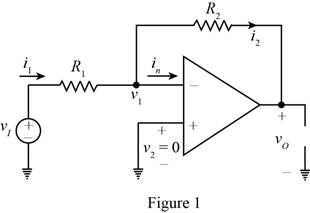
Concept explainers
(a) In an inverting op-amp circuit, the nominal resistance values are
(a)
The maximum deviation in the voltage gain from its nominal value for
Answer to Problem 9.13P
The maximum deviation of the voltage gain from the nominal value is
Explanation of Solution
Calculation:
The given diagram is shown in Figure 1

The expression for the voltage gain of the circuit is given by,
The expression for the voltage
Substitute
The expression for the value of the current
The expression for the value of the current
Substitute
Substitute
Substitute
Substitute
Substitute
The expression for the maximum value of the voltage gain is given by
Substitute
The expression for the minimum value of the voltage gain is given by,
Substitute
The expression for the deviation of the voltage gain from the maximum voltage is given by,
Substitute
The expression for the minimum deviation of the voltage gain is given by,
Substitute
The expression for the deviation in the voltage gain is given by,
Conclusion:
Therefore, the maximum deviation of the voltage gain from the nominal value is
(b)
The maximum deviation in the voltage gain from its nominal value for
Answer to Problem 9.13P
The maximum deviation of the voltage gain from the nominal value is
Explanation of Solution
Calculation:
The expression for the maximum value of the voltage gain is given by
Substitute
The expression for the minimum value of the voltage gain is given by,
Substitute
The expression for the deviation of the voltage gain from the maximum voltage is given by,
Substitute
The expression for the minimum deviation of the voltage gain is given by,
Substitute
The expression for the deviation in the voltage gain is given by,
Conclusion:
Therefore, the maximum deviation of the voltage gain from the nominal value is
Want to see more full solutions like this?
Chapter 9 Solutions
Microelectronics: Circuit Analysis and Design
- The op amp in the circuit shown shown is ideal. The adjustable resistor RΔ has a maximum value of 100 kΩ, and a is restricted to the range of 0.2 =a=1. Calculate the range of vo if vg=40 mV.arrow_forwardCompare the op amp’s output voltage to the power supply voltages todetermine if the op amp is operating in its linear region or if it issaturated.arrow_forwardBased on the op amp circuit in Figure, answer the following questions,assuming an ideal op-amp. Given:V1 = 1 VI2 = 2 mAV3 = 0.5 VRa = 2 kΩRb = 1 kΩRc = 5 kΩRd = 10 kΩVx = 4VIb = 3.5mANow I need to determine Vo and the current and power through Rd.Please help, Thank youarrow_forward
- The resistor Rf in the circuit attached is adjusted until the ideal op amp saturates. Specify Rf in kilo-ohms.arrow_forwardAssume that the op amp in the circuit shown is ideal. 1. Calculate vo for the following values of vs: 0.4, 2.0, 3.5, −0.6, −1.6, and −2.4 V. 2. Specify the range of vs required to avoid amplifier saturation.arrow_forward(a) An inverting amplifier with resistors R1=5.6 kQ and R2 = 120 kg is fabricated using an op amp with an open-loop gain of 105. What is the percent difference between the actual gain and the ideal gain? (b) Repeat part (a) if R1 is changed to R1 8.2 kA.arrow_forward
- Based on the op amp circuit in Figure, answer the following questions,assuming an ideal op-amp. Given:V1 = 1 VI2 = 2 mAV3 = 0.5 VRa = 2 kΩRb = 1 kΩRc = 5 kΩRd = 10 kΩ Determine the voltage Vx, and the current Ib through Rbarrow_forwardIn the op-amp circuit shown below, find V0. 30 kQ Select one: O avo=6V O b.vo=3v c. None of the above ) d.VO=9Varrow_forwardAssume that Op amp shown is ideal. Given that R1 is 24 Ohm, R2 is 75 Ohm, R3 is 12 Ohm, R4 is 187.5 Ohm. Calculate Vo (Volts).arrow_forward
- Determine the output voltage of an op amp amplifier circuit with the following parameters: Differential voltage gain = 4522CMRR = 631Vi1 = 659 mV Vi2 = 659 mV Vi1 and Vi2 are in phase and have the same frequency. \ QUICKLYarrow_forwardHi!! I need answer, ASAP. Thank you! Calculate the output impedance of an inverting op-amp using the 741 op-amp (ro =100 Ohms, AOL =200,000) if Ri = 33 kilo Ohms and Rf = 77 kilo Ohms.arrow_forwardAn op-amp with an open-loop gain of 3x106 and Vcc = 12 V has an inverting-input voltage of 6.7 microVolts and a non-inverting input voltage of 5.4 microVolts. What is its output voltage? Be sure to round your answer to the nearest single digital decimal place. Do not enter units. As an example, if you calculate 7.39 Volts then enter 7.4 as your submitted answerarrow_forward
 Introductory Circuit Analysis (13th Edition)Electrical EngineeringISBN:9780133923605Author:Robert L. BoylestadPublisher:PEARSON
Introductory Circuit Analysis (13th Edition)Electrical EngineeringISBN:9780133923605Author:Robert L. BoylestadPublisher:PEARSON Delmar's Standard Textbook Of ElectricityElectrical EngineeringISBN:9781337900348Author:Stephen L. HermanPublisher:Cengage Learning
Delmar's Standard Textbook Of ElectricityElectrical EngineeringISBN:9781337900348Author:Stephen L. HermanPublisher:Cengage Learning Programmable Logic ControllersElectrical EngineeringISBN:9780073373843Author:Frank D. PetruzellaPublisher:McGraw-Hill Education
Programmable Logic ControllersElectrical EngineeringISBN:9780073373843Author:Frank D. PetruzellaPublisher:McGraw-Hill Education Fundamentals of Electric CircuitsElectrical EngineeringISBN:9780078028229Author:Charles K Alexander, Matthew SadikuPublisher:McGraw-Hill Education
Fundamentals of Electric CircuitsElectrical EngineeringISBN:9780078028229Author:Charles K Alexander, Matthew SadikuPublisher:McGraw-Hill Education Electric Circuits. (11th Edition)Electrical EngineeringISBN:9780134746968Author:James W. Nilsson, Susan RiedelPublisher:PEARSON
Electric Circuits. (11th Edition)Electrical EngineeringISBN:9780134746968Author:James W. Nilsson, Susan RiedelPublisher:PEARSON Engineering ElectromagneticsElectrical EngineeringISBN:9780078028151Author:Hayt, William H. (william Hart), Jr, BUCK, John A.Publisher:Mcgraw-hill Education,
Engineering ElectromagneticsElectrical EngineeringISBN:9780078028151Author:Hayt, William H. (william Hart), Jr, BUCK, John A.Publisher:Mcgraw-hill Education,





